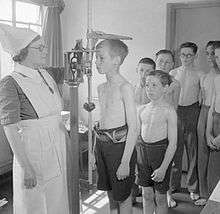School nursing
School nursing, a specialized practice of public health nursing, protects and promotes student health, facilitates normal development, and advances academic success. School nurses, grounded in ethical and evidence-based practice, are the leaders that bridge health care and education, provide care coordination, advocate for quality student-centered care, and collaborate to design systems that allow individuals and communities to develop their full potentials.[1]

United States
According to the National Association of School Nurses, there are approximately 61,232-73,697 Registered Nurses (RNs) working in elementary and secondary schools (K-12) in the United States depending on the survey sample ( - need these references: HRSA,2010; ACS, 2013), which represents between 2.1-2.8% of Registered Nurses in the United States.[2] According to the American Federation of Teachers, there are approximately 45,000 school nurses employed in the United States.[3] School nurses are often the only health professional serving students in an educational setting.
Notable school nurses
- Roz Hanby
- Annie McKay, first school nurse in Massachusetts, 1905[4]
- Lina Rogers Struthers, first school nurse in the United States, in New York City, 1902[5]
- Kris Krull, Miss New York 1975
- Anne Sheetz, Director of School Health Services, Massachusetts Department of Public Health, 1986-2014
United Kingdom

In 1892 Amy Hughes was working in Bloomsbury Square as the Superintendent of Queen's Nurses. She was asked to visit a local elementary school to advise about nutrition. Hughes was surprised to find that the students were suffering with minor ailments that was contributing to school days lost to sickness. Hughes would in time arrange for Queen's nurses to visit schools. She is credited with being the first School Nurse in the UK.[6]
The statutory provision of school nursing in all schools in the UK arose out of the Boer War. A large proportion of army volunteers - between 40% and 60% - had been found to be medically unfit for service, so in 1903, the government set up the Interdepartmental Committee on Physical Deterioration to study the causes. In 1904 the Committee reported back, saying that there was no general health problem, but treatable conditions had been left untreated, meaning that the conditions had worsened to they extent that they became debilitating. The Committee recommended that:
- children have medical inspections in schools
- free school meals be provided to children from extremely poor families
- mothers be trained in child upbringing
The government reacted first by passing the 1906 Provision of School Meals Act, which allowed (but did not compel) local authorities to provide school meals, at no cost to the poor, and to raise a tax to pay for this. Then the 1907 Education Act was passed, which established a team of school nurses at every local authority. This was accompanied by the 1907 Medical Inspections Act, which required local authorities to ensure that each child received a total of at least 3 medical inspections during their time at school. Although the Act established clinics within schools to treat anything discovered, parents were expected to pay for the treatment themselves; after 1912 the government made small contributions towards the cost.
In modern times, school nurses are comparable to health visitors, but specialise in a school setting, rather than a domestic one. As such they normally take over public health responsibilities for children, from health visitors, once the children are over 5 and start attending school. Like health visitors, they monitor child development, and deliver certain vaccination programmes, as well as instigating the child safeguarding process when they suspect a child is being abused or neglected. Given their physical setting, they are also often called upon to provide first aid, and it is for this that they are most familiar to children.
In the mid to late 20th century, school nurses were often familiar to children as the nit nurse - a specialist nurse who inspects children's head hair for lice, and lice-eggs (colloquially known as nits). In 1947, 8% of school children suffered from lice infections, but the use of nit nurses had managed to reduce that to 3% within a decade. Skin infections of any kind, which were once common, had become a rare phenomena by the end of the century, except those which afflict the soles of the feet. Under the Blair Ministry, nit nursing came to be seen as not being clinically cost-effective, and nit nursing was gradually withdrawn from schools.
Following the Cameron Ministry's reorganisation of the National Health Service, School Nurses fall under the general aegis of Public Health England, but are locally commissioned by local authorities, who now hold local responsibility for public health. To become qualified Registered School Nurses, ordinary nurses undertake additional training as Specialist Community Public Health Practitioners. They are regulated by the Nursing and Midwifery Council.
Footnotes
- "NASN | Role & Career". www.nasn.org. Archived from the original on 5 August 2016. Retrieved 4 August 2016.
- "NASN Frequently Asked Questions". National Association of School Nurses. Archived from the original on 25 July 2016. Retrieved 1 August 2016.
- "Archived copy". Archived from the original on 11 February 2005. Retrieved 5 February 2005.CS1 maint: archived copy as title (link)
- "Annie McKay: School Nurse Pioneer" (PDF). American Association for the History of Nursing Bulletin. Archived from the original (PDF) on 24 August 2011. Retrieved 1 August 2016.
- Pollit, P (February 1994). "Lina Rogers Struthers: the first school nurse". Journal of School Nursing. 10 (1): 34–6. PMID 8161875.
- Nadine Schwab; Mary Gelfman (July 2005). Legal Issues in School Health Services: A Resource for School Administrators, School Attorneys, School Nurses. iUniverse. p. 7. ISBN 978-0-595-35813-7.
Further reading
- School Nursing: Scope and Standards of Practice (2011). American Nurses Association and National Association of School Nurses. Silver Springs, MD: nursesbooks.org, the publishing program of ANA.
- Richard A. Meckel, Classroom and Clinics: Urban Schools and the Protection and Promotion of Child Health, 1870-1930. New Brunswick, NJ: Rutgers University Press, 2013.